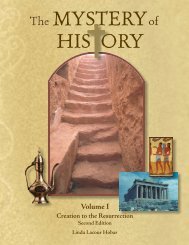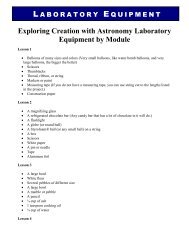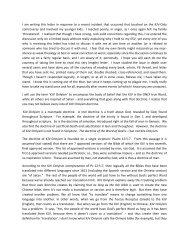Archeology Book.pdf
Archeology Book.pdf
Archeology Book.pdf
- No tags were found...
You also want an ePaper? Increase the reach of your titles
YUMPU automatically turns print PDFs into web optimized ePapers that Google loves.
fi Ancient Alexander’sSarcophagus detailFirst Printing February 2010Copyright © 2010 by David Down. All rights reserved.No part of this book may be reproducedin any manner whatsoever without writtenpermission of the publisher except inbrief quotations in articles and reviewsFor more information write:Master <strong>Book</strong>s ®P.O. Box 726Green Forest, AR 72638Printed in the United States of AmericaCover and Interior Design by Diana BogardusPlease visit our website for other great titles:www.masterbooks.netISBN: 978-0-89051-573-0Library of Congress number: 2010920107All Scripture references are from theKing James Version unless otherwise noted.
HOW TO USE THIS BOOK5CHAPTER2413WHAT ARCHAEOLOGY ISALL ABOUT 6LAND OF EGYPT20THE HITTITES30UR OF THE CHALDEES366857ASSYRIA42BABYLON: CITY OF GOLD46PERSIA52PETRA6010911THE PHOENICIANS70THE DEAD SEA SCROLLS78ISRAEL84GLOSSARY & INDEX94
OUR BEST-SELLING WONDERS OF CREATIONSERIES IS GETTING EVEN BETTER!With this title, the series is being developed in an enhanced educationalformat and integrated with a unique color-coded, multi-age leveldesign to allow ease of teaching the content to threedistinct grade levels.4› Antique monument at theRoman forum
HOW TO USE THIS BOOK‹ Level 1‹ Level 2‹ Level 3The Archaeology <strong>Book</strong> has been developed with three educational levels in mind.These can be utilized for the classroom, independent study, or homeschool setting. Forbest possible comprehension, it is recommended that every reader examine the texton the yellow background. More skilled readers can then proceed to the gray/blue sections aswell. Finally, the most advanced readers may read through all three sections. Look for the followingicons and special features throughout the book:wonderdd'sd'whyjournalLEVEL ONE‹ Text on yellow background‹ 5th to 6th grades‹ The basic level is presented for youngerreaders and includes the DD’s Journaland Wonder Why segments.BIG5These sections uncoverthe answers to intriguingquestions relating tohistory, archaeology, anddiscovery.WHOWHATWHEREWHYHOWEach chapteraddresses thewho, what, where,why, and howof importantarchaeologicaland historicalinformation. Thisinformation may befound on any level.FIELD JOURNALAuthor David Down provides uniqueinsights into his over 40 years ofarchaeological discovery.LEVEL THREE‹ Text on white background‹ 9th to 11th gradesLEVEL TWO‹ Text on blue/gray background‹ 7th to 8th grades‹ This middle level delves deeper intoarchaeological discoveries and issuesrelated to historical concerns, utilizingWords to Know and Reflections.These words foundthroughout the upcomingchapter present a quickglimpse of importantconcepts coming up.Utilizing informationarising in the chapter, thesesegments offer questionsthat probe further intoarchaeological topics.‹ This upper level incorporates conceptsand theories related to all subjectmatter included in the text, as wellas unique information within the DigDeeper sections.This final level takes thereader into controversialand critical issuespertaining to historicalaccounts, chronologies,dating methods, and more.5
Archaeology: the study of history – the historyof the daily life of people and families and countriesfrom hundreds and thousandsof years ago.BIG5WHOWHATWHEREWHYHOWWhat ArchaeologyIs All AboutWho is an archaeologist?What does the word“archaeology” mean?Where do archaeologistsprimarily work?Why were ancient citiesbuilt on hills?How do archaeologiststry and determine howold things are?wonderwhyWHY STUDY ARCHAEOLOGY?Through a method of study, archaeology canshow us how people lived and died, and whatit was like to live in their cities back then.Archaeology can find information about whatthey ate, what they wore, what money they used,what their weather was like, if and how theyfought with other people, and what form of governmentthey had. By using a method of discovery—excavationand research—archaeologistscan answer these and many other questions.BCADSYSTEM OF DATINGBefore ChristYears beforethe Lord’sbirthAnno DominiThe yearof our LordSecular scientistsoften refer tothis as BCE(Before Common Era)Secular scientistsoften refer tothis as CE(Common Era)€ Archaeologists work aroundthe globe in every countryand continent discoveringclues and details on ancientcivilizations.6
€ Archaeology€ Strata€ Chronology€ Hieroglyphs€ DynastyThe usual view of archaeologyis of an archaeologistdown on hands and kneescarefully brushing the dustfrom some fabulous treasurethat has just emerged fromthe earth. Well, occasionallysome gold or silver objectdoes come to light, and it isrewarding if it does, but really,that is not what archaeology isall about.The word archaeology isderived from two Greek words:arche, meaning “beginning,”and logos, meaning“word,” and that sums itup—words about beginnings.Archaeologists are diggingup the past, reconstructinghistory, finding out whathappened, when it happened,and how it happened, and apiece of broken pottery maytell us more than a goldendeath mask.› An archaeologist is ascientist or explorer whouses a methodical process toexcavate and study ruins andartifacts from ancient cultures.‹ How do archaeologistsknow what life was like inthe past?‹ What clues can be found,and where do they lookfor these clues?‹ Why can a tiny piece ofbroken pottery tell usmore about history thangold or treasure can?7
WHY WERE CITIES BUILT ON HILLS?‹ It provided an advantage if the city was attacked by an enemy. If the attackers had to scrambleup the side of a hill before they tried to breach the wall, it gave the defenders an advantage.‹ Palestine can get rather hot in summer and a city on a hilltop would catch the summer breezes.‹ There can be heavy rain in winter and a city on a hill was not likely to be washed away. This alsowas referred to by Jesus when He concluded His Sermon on the Mount by referring to the wiseman who built his house on the rock, and the foolish man who built his house on the sand(Matt. 7: 24–27).meters) above the originalheight of the hill. The final hillis then called a tell, which issimply a mound filled withancient ruins.And why was the city abandoned?As the sides of thehill did not rise vertically, thearea on top was graduallyreduced, yet the populationkept growing. They ran out ofliving space. Also, as time progressed,the residents learnedto trust more in their armiesthan in their walls, so by theRoman period most cities werebuilt on the plains.So when an archaeologistdecides to do some excavating,he goes to one of thesetells and starts digging down,exposing the successive layersof occupation. It is surprisinghow these layers, called strata,can be distinguished. It may benecessary to remove the surfaceaccumulation of dirt anddebris with a pick, or sometimeseven abulldozer, butwhen artifacts begin to appear,most of the digging is donewith hoes. The debris is collectedin buckets, placing anyantiquities or broken potteryin labelled buckets. The labelswill indicate where and whenthe contents of the bucketcame from. Spades or shovelsare never used, primarily becausethey are too destructiveto the artifacts.Jesus referred to cities on a hill in His Sermon on theMount when He said, “A city that is set on an hill cannotbe hid…. Let your light so shine before men, that theymay see your good works, and glorify your Father whichis in heaven.”Matt. 5:14,169
POTTERY AND ITS SECRETSPottery is invaluable to the archaeologist forseveral reasons.‹ First, it is plentiful. Everyone had to havepottery: pots, jars, jugs, plates, and otherhousehold items. It was just made out of clayso it was comparatively cheap, and therewas no alternative. There was no plastic orstainless steel. It had to be pottery.‹ Second, pottery was very fragile. A carelesskid could easily knock a bowl off the tableand break it.‹ Third, it was just about immortal. Buried ironwill rust, silver could turn to powder, butpottery could be buried 3,000 years andwhen unearthed is almost as good as when itwas buried.The secret to identification is in the style — theshape, size, and ornamentation. In most of theMiddle East, similar styles were the same inmost countries. Pottery styles changed fromtime to time. New fashions came on the marketfrom the potter’s wheel, and everyone seemedintent on having the latest style oil lamp orceramic jug. The old ones either got broken andthe pieces thrown away for the archaeologistto find, or even the good old things got tossedon the rubbish dump. Whichever it was, thesepottery pieces hold the clue to the past.So on most digs the workers will find hundredsof pieces of pottery every day, and they all haveto be carefully placed in the “finds buckets” andsent for pottery washing. Every piece has to becarefully scrubbed with water and a nail brush,and examined to see if there might be sometelltale mark on it, or maybe an inscription.INTERPRETING FINDINGSOccasionally an archaeologist may challenge the identificationor interpretation of the original excavators. He can go to the store roomsand examine the remains to either agree with the first archaeologists or differfrom their views. This happened when Professor Kenneth Wood disagreed withthe conclusions Kathleen Kenyon had come to about Jericho being uninhabitedwhen Joshua and his army arrived there. He examined thepottery found by her in Jericho andconcluded that Kenyon hadmade a mistake in herconclusions. Thatis a problem witharchaeology. It isnot only what youfind; it is how youinterpret whatyou find.€excavation site of Jericho10
wonderWHY STUDYCOINS?whyA coin will probablyhave some informationon it that will reveal thedate the coin was issued,but coins were not useduntil about 600 BC; soanything before thendepends on other clues.Sometimes coins werekept until a later periodand then dropped, socoins can only tell us theearliest possible dateof the layer in which itwas found, not the latestpossible date.PROBLEMS WITH THE IRON AGEThe following period, Iron Age I, is usually dated to 1200BC, but here again is a problem for the traditionalists. This iswhat Finklestein wrote: “The Iron I period again witnessed adramatic swing in the population of the hill country, this time inthe opposite direction .... MB II, Late Bronze and Iron I periodsleave two critical questions for which satisfactory answersmust be found. Why and to where did over half of the MB IIpopulation, i.e., virtually all the inhabitants of the hill country,‘vanish’? From where did the people who settled the hundredsof sites in Iron I ‘materialize’?” 1In the first year of Cyrus king of Persia, that the wordof the LORD by the mouth of Jeremiah might be fulfilled,the LORD stirred up the spirit of Cyrus king of Persia,that he made a proclamation throughout all his kingdom,and put it also in writing, saying, Thus saith Cyrus kingof Persia, The LORD God of heaven hath given me all thekingdoms of the earth; and he hath charged me to buildhim an house at Jerusalem, which is in Judah. Who is thereamong you of all his people? his God be with him, and lethim go up to Jerusalem, which is in Judah, and build thehouse of the LORD God of Israel, which is in Jerusalem.And they went. No needto ask where all the IronAge people came from.The Bible has the obviousanswer.(Ezra 1:1-3)This also solves anotherarchaeological problem.Archaeologists have beenunable to find much trace of thePersian Period, which in theirthinking would have followedthe Iron Age. Seals, inscriptions,and artifacts have been found,but there was scant evidence fromarchaeological strata. The PersianPeriod should be recognized as theearly Iron Age when the Israelitescame back from exile.‹Darius I of Persia13







